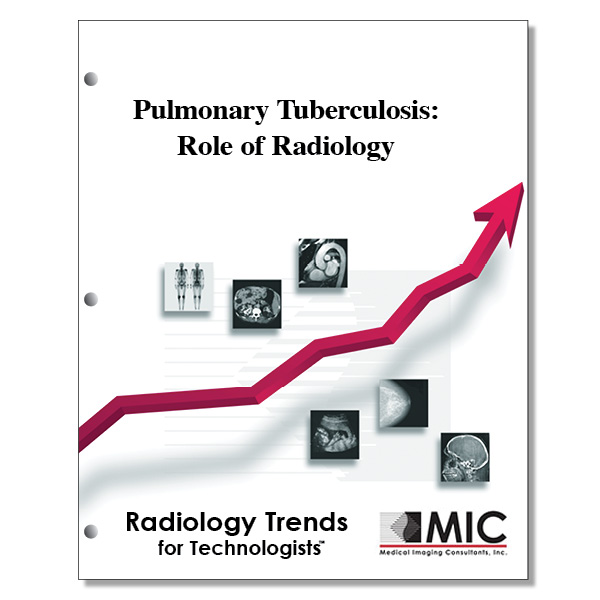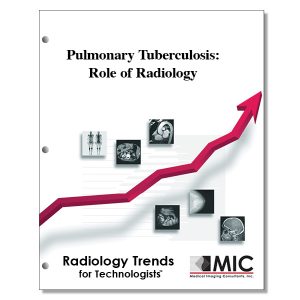

Pulmonary Tuberculosis: Role of Radiology
The radiologic appearance of pulmonary tuberculosis is discussed with an emphasis on the role of imaging within the clinical context.
Course ID: Q00535 Category: Radiology Trends for Technologists Modalities: CT, Radiography3.0 |
Satisfaction Guarantee |
$34.00
- Targeted CE
- Outline
- Objectives
Targeted CE per ARRT’s Discipline, Category, and Subcategory classification for enrollments starting after March 18, 2024:
[Note: Discipline-specific Targeted CE credits may be less than the total Category A credits approved for this course.]
Computed Tomography: 2.00
Procedures: 2.00
Neck and Chest: 2.00
Radiography: 2.00
Procedures: 2.00
Thorax and Abdomen Procedures: 2.00
Registered Radiologist Assistant: 3.00
Patient Care: 0.25
Patient Management: 0.25
Procedures: 2.75
Thoracic Section: 2.75
Outline
- Introduction
- Risk Factors
- Clinical Features
- Active Tuberculosis
- Primary Tubersulosis
- Lymphadenopathy
- Parenchymal disease
- Pleural Effusion
- Airway Disease
- Miliary Tuberculosis
- Postprimary Tuberculosis
- Consolidation and Cavitation
- Centrilobular Nodules
- Tuberculosis in Immunocompromised Patients
- Pediatric Tuberculosis
- Primary Tubersulosis
- Laboratory Evaluation of Active Tuberculosis
- Staining
- Culture
- Nucleic Acid Amplification Test
- Latent Tuberculosis
- Tests for Infection
- Tuberculin Skin Test
- Interferon-g Release Assays
- Screening Tests in Patients with Active Tuberculosis
- Role of Imaging in Diagnosis and Management
- Nontuberculous Myobacteria
- Conclusion
Objectives
Upon completion of this course, students will:
- be familiar with the causes of tuberculosis
- know which factors affect the probability of transmission of tuberculosis from one individual to another
- know the three categories of tuberculosis infection and what defines them
- be familiar with how primary tuberculosis infections develop
- understand which groups are at increased risk of exposure to tuberculosis
- understand which groups are at higher risk of progression to active tuberculosis
- know the typical symptoms of active tuberculosis
- know the common sites for the spread of extrapulmonary tuberculosis
- know why any radiologic finding that raises the possibility of active tuberculosis must be promptly communicated to the referring provider
- be familiar with the appearance of lymphadenopathy on contrast-enhanced CT images
- know how parenchymal disease most frequently manifests
- be familiar with the appearance of pleural effusion on a radiograph
- be familiar with the appearance of airway disease on a radiograph
- be familiar with the appearance of miliary tuberculosis on a chest radiograph
- be familiar with the appearance of miliary tuberculosis on CT images
- be familiar with the appearance of tuberculous empyemas on a radiograph
- know how patients with postprimary tuberculosis typically present
- understand the role of imaging in patients with postprimary tuberculosis
- know what percentage of patients with postprimary tuberculosis show cavitation on chest radiogaphs
- know what percentage of patients with active tuberculosis show centrilobular nodules on CT images
- understand how much more likely HIV-positive patients with latent tuberculosis infection are to develop active tuberculosis than HIV-negative patients
- be familiar with laboratory testing for active tuberculosis
- know the sensitivity of the smear for AFB in patients with culture-positive tuberculosis
- know the sensitivity of the smear for AFB in HIV-positive patients
- understand the features that are characteristic of inactive tuberculosis
- understand the appropriate initial testing for patients suspected of having latent tuberculosis
- know what the chest radiography report should indicate in patients suspected of having latent or inactive tuberculosis
- understand the factors that can cause a false-positive result with the tuberculin skin test
- understand the factors that can cause a false-negative result with the tuberculin skin test
- know how the interferon-γ release assay test works
- know the advantages of using the interferon-γ release assay test
- be familiar with the initiation phase for patients with active tuberculosis
- be familiar with the continuation phase for patients with active tuberculosis
- understand the bactericidal phase for patients with active tuberculosis
- know the typical treatment regimen for latent tuberculosis
- be familiar with the clinical features of classic nontuberculous mycobacterial disease
- be familiar with the clinical features of nonclassic nontuberculous mycobacterial disease
- know the patient population that classic nontuberculous mycobacterial disease typically affects
- know the patient population that nonclassic nontuberculous mycobacterial disease typically affects
- be familiar with the typical treatment for nontuberculous mycobacterial disease
